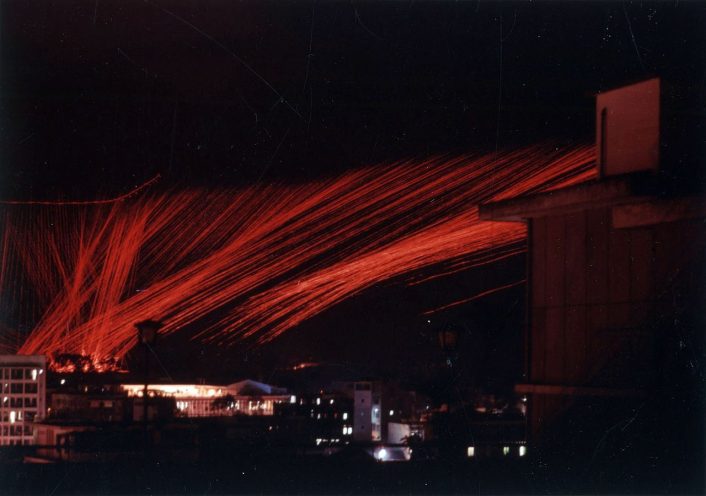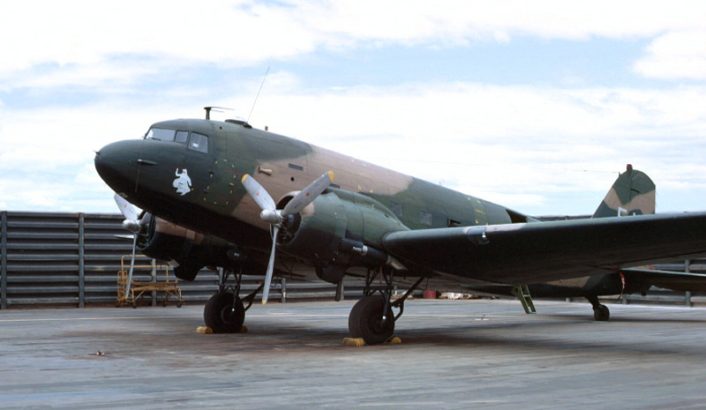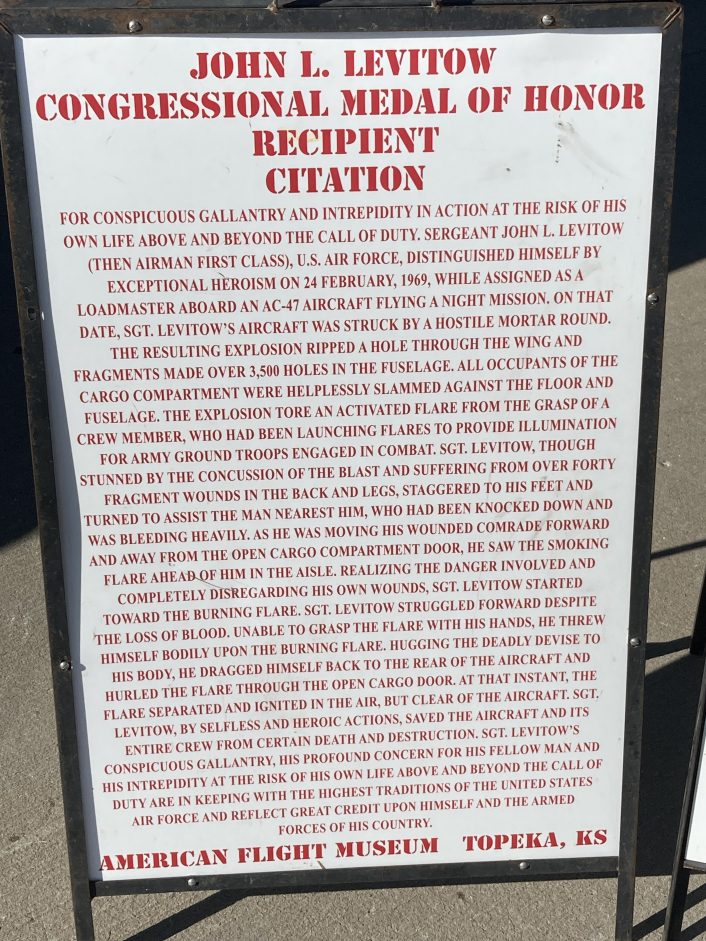Unleashing horrifying firepower and raining death and destruction on to the communist forces in Vietnam from the dark skies above, the AC-47 fixed-wing gunship was the first of its kind.
Creating a Monster
Giving cargo aircraft a new mission, the gunship conversions created during the Vietnam War provided close air ground support to troops on the ground, in order to protect villages and outposts from being overwhelmed by mass attacks from the VC (Viet Cong). The idea grew out of experiments in 1964 during project “Tailchaser,” led by U.S. Air Force Captain John Simons and involving a Convair C-131B cargo aircraft carrying cameras to record target tracking while keeping the aircraft in a steady banked turn.
Budget restrictions delayed the implementation of the idea until Air Force Captain Ron Terry became involved. Terry took the C-131 and, with Lieutenant Ralph Kimberlin, mounted a GAU-2A Gatling gun out the cargo door of the aircraft. The gun pointed out the left side of the C-131 and the pilot was able to hit targets with ease flying in a steep left-hand banking circular pattern (pylon turn), which allowed the gun to be aimed at and saturate a relatively small area.
Instead of the C-131B initially used, the more plentiful C-47 was chosen for the first operational fixed wing gunship by the United States Air Force. The Douglas C-47 transport had been in service since the 1930s, and was affectionately known by many names: “Skytrain”, “Dakota”, and “Gooney Bird”. Serving as a civil airliner, the aircraft was known as the DC-3. Reliable, economical, and able to perform a variety of tasks, the Douglas design is one of history’s most significant aircraft. Under the efforts of Captain Terry, who at times used his personal funds to move the project forward, the first AC-47 version flew in Vietnam in Dec. 1964.
Originally designated the FC-47 (Fighter Cargo), complaints from fighter pilots persuaded a re-designation to the AC-47 (Attack Cargo). The gunship would eventually be armed with three six-barrel 7.62 x 51 mm NATO (North Atlantic Treaty Organization) “miniguns”, capable of firing up to 6,000 rounds per minute. Two guns were mounted pointing out the last two windows aft of the port wing, and one out the open cargo door on the same side. Later improvements resulted in the GAU-2A/M134 being replaced with the SUU-11BA podded installation of the weapons. A battery of three minigun pod installations could saturate an area the size of a football field in less than 10 seconds. Muzzle velocity for the 147 grain ball projectile was around 2,800 feet per second and every fifth round was a tracer round.
The crew consisted of a pilot, co-pilot, navigator, loadmaster, two armament system specialists, and a South Vietnamese observer responsible for communicating with the ARVN (Army of the Republic of Vietnam) troops. The pilot aimed from the cockpit out the left-hand window with a makeshift surplus gun site and fired the weapons remotely from the control column, and the armament specialists removed stoppages and reloaded the weapons. The loadmaster or armament specialists also had the job of deploying flares to illuminate the battlefield, since this was a weapon used mostly at night.
The twin-engine AC-47D was powered by two Pratt & Whitney R-1830 Twin Wasp radial piston engines producing 1,200 horsepower each, giving the gunship a top speed of around 230 mph. Range was over 2,000 miles giving the plane ample time to linger around a fight or be airborne and on standby.
A Fire-Breathing Dragon
The sight and sound of an AC-47 at night firing as many as three miniguns at up to 6,000 rounds a minute with every fifth round a tracer was impressive to say the least. Enemy troops were killed, wounded, or run away in terror, either way ending the fight. The aircraft fired from too great an altitude so the tracers would burn out before reaching the ground, and that, coupled with the limited range of the rounds, required the AC-47 to fly at low altitudes. The gunship became known as “Puff the Magic Dragon” because of the intense nocturnal light show it produced. The name was borrowed from a popular song of the same title by the musical trio of Peter, Paul, and Mary, much to their chagrin.

Call Sign “Spooky”
The radio call sign for the AC-47 was “Spooky.” With the aircraft operating at night circling the battlefield for long periods of time, droning along drooping illumination flares and belching out rounds at an unprecedented rate, the name seemed appropriate and stuck. The first missions proved so successful that soon the Air Force was pulling the old C-47s from storage and modifying them into AC-47 gunships. By late 1965, twenty AC-47s had arrived in Vietnam and formed the 4th Air Commando Squadron, followed by more aircraft and the 14th Air Commando Squadron in 1967. Training for the gunship was at Forbes Air Force Base, Topeka, Kansas.
Some of the early uses of the gunships included attacking the Ho Chi Minh Trail in Laos, which was defended by anti-aircraft weapons and surrounded by steep mountains. The slow moving and low flying AC-47 didn’t fare well in that environment, as well as the 7.62 rounds which, while being highly effective on personnel, didn’t always damage trucks and vehicles enough to put them out of action. Four AC-47s were lost before the remaining aircraft were called back to South Vietnam. The gunships found their niche in defending outposts, villages, firebases etc. from the nocturnal attacks by high concentrations of VC troops.
The night operations of the AC-47 proved relatively safe, as the aircraft was vulnerable to ground fire. But the raiding VC attacking special force’s outposts and villages rarely carried heavy machine guns or anti-aircraft weapons, favoring traveling light using hit and run tactics. This kept loses down for the aircraft.

Tally of Terror
The last American AC-47 flights occurred in Dec. 1969. Between 4,000 and 6,000 outposts and hamlets had been defended and not a single position ever defended by the aircraft was ever overrun. In the first eleven days of operation in Vietnam, the AC-47s fired 179,710 rounds of 7.62 mm. On one mission on Feb. 8, 1965, an AC-47 loitered over a VC offensive for over four hours and poured 20,500 rounds into their position, ending the attack. There are numerous stories from servicemen in regards to the AC-47 and its firepower saving them in the midst of overwhelming odds. A total of 41 AC-47s served in Vietnam, with 19 lost, 12 of those in combat. In total 53 C-47s were converted to AC-47s by the United States. The concept had proven itself, and it was time to improve the concept.
Newer Gunships
Most of the AC-47s in American use in Vietnam were replaced by newer model aircraft by 1969. Lessons learned over the Ho Chi Minh Trail lead to the installation of heavier weapons in addition to the miniguns, in order to deal with vehicles and harder targets. The newer gunships would be based on the Fairchild C-119 (AC-119) and the Lockheed C-130 Hercules (AC-130). Many remaining AC-47s found their way into the inventory of RVNAF (Republic of Vietnam Air Force) and were lost to North Vietnam when the war ended.
A Ghost from the Past
Being such a prolific aircraft, gunship versions of the C-47 served with many countries, some being transferred from U.S. inventories, some nations converting the aircraft into their own versions. One aircraft of a more recent note is the Basler BT-67, a remanufactured C-47 built by Basler Turbo Conversions of Oshkosh, Wisconsin. Colombia began operation of 5 armed BT-67s in 2006, using them for counter-insurgency operations against armed groups. Though not a version of the AC-47, the aircraft is armed with .50 caliber GAU-19A machine guns as well as the ability to carry bombs, and is even reported to have been spotted with a 20 mm cannon installed on one example. The idea of the fixed wing gunship lives on.


